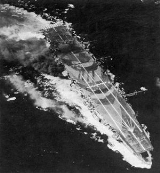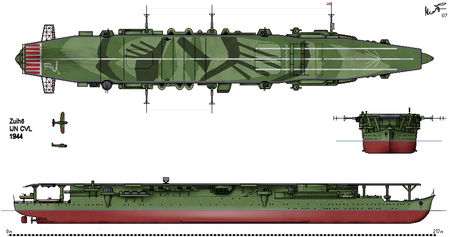
Japanese aircraft carrier Zuiho
Encyclopedia
was a light aircraft carrier
of the Imperial Japanese Navy
. During the Second World War, she participated in many operations, including the battles of Santa Cruz
, Philippine Sea
and Leyte Gulf
where she was finally sunk by American aircraft.
. As the Japanese became aware of the importance of carrier aviation, the Takasaki was converted in January 1940 to an aircraft carrier and renamed Zuihō. Zuihō was the sister ship
of , which was sunk by US aircraft at the Battle of the Coral Sea
.
Her aircraft complement consisted of 16 Mitsubishi A5M
"Claude" fighter
s and 14 Nakajima B5N
1 "Kate" torpedo bomber
s.

Light aircraft carrier
A light aircraft carrier is an aircraft carrier that is smaller than the standard carriers of a navy. The precise definition of the type varies by country; light carriers typically have a complement of aircraft only ½ to ⅔ the size of a full-sized or "fleet" carrier.-History:In World War II, the...
of the Imperial Japanese Navy
Imperial Japanese Navy
The Imperial Japanese Navy was the navy of the Empire of Japan from 1869 until 1947, when it was dissolved following Japan's constitutional renunciation of the use of force as a means of settling international disputes...
. During the Second World War, she participated in many operations, including the battles of Santa Cruz
Battle of the Santa Cruz Islands
The Battle of the Santa Cruz Islands, 26 October 1942, sometimes referred to as the Battle of Santa Cruz or in Japanese sources as the , was the fourth carrier battle of the Pacific campaign of World War II and the fourth major naval engagement fought between the United States Navy and the Imperial...
, Philippine Sea
Battle of the Philippine Sea
The Battle of the Philippine Sea was a decisive naval battle of World War II which effectively eliminated the Imperial Japanese Navy's ability to conduct large-scale carrier actions. It took place during the United States' amphibious invasion of the Mariana Islands during the Pacific War...
and Leyte Gulf
Battle of Leyte Gulf
The Battle of Leyte Gulf, also called the "Battles for Leyte Gulf", and formerly known as the "Second Battle of the Philippine Sea", is generally considered to be the largest naval battle of World War II and, by some criteria, possibly the largest naval battle in history.It was fought in waters...
where she was finally sunk by American aircraft.
Design
Zuihō was first laid down as the high-speed oiler Takasaki in 1934 and later redesigned as a submarine tenderSubmarine tender
A submarine tender is a type of ship that supplies and supports submarines.Submarines are small compared to most oceangoing vessels, and generally do not have the ability to carry large amounts of food, fuel, torpedoes, and other supplies, nor to carry a full array of maintenance equipment and...
. As the Japanese became aware of the importance of carrier aviation, the Takasaki was converted in January 1940 to an aircraft carrier and renamed Zuihō. Zuihō was the sister ship
Sister ship
A sister ship is a ship of the same class as, or of virtually identical design to, another ship. Such vessels share a near-identical hull and superstructure layout, similar displacement, and roughly comparable features and equipment...
of , which was sunk by US aircraft at the Battle of the Coral Sea
Battle of the Coral Sea
The Battle of the Coral Sea, fought from 4–8 May 1942, was a major naval battle in the Pacific Theater of World War II between the Imperial Japanese Navy and Allied naval and air forces from the United States and Australia. The battle was the first fleet action in which aircraft carriers engaged...
.
Her aircraft complement consisted of 16 Mitsubishi A5M
Mitsubishi A5M
The Mitsubishi A5M, Japanese Navy designation was "Type 96 carrier-based fighter" was a Japanese carrier-based fighter aircraft. It was the world's first monoplane shipboard fighter and the direct ancestor of the famous Mitsubishi A6M 'Zero'...
"Claude" fighter
Fighter aircraft
A fighter aircraft is a military aircraft designed primarily for air-to-air combat with other aircraft, as opposed to a bomber, which is designed primarily to attack ground targets...
s and 14 Nakajima B5N
Nakajima B5N
|-See also:-References:NotesBibliography* Bridgwater, H.C. and Peter Scott. Combat Colours Number 4: Pearl Harbor and Beyond, December 1941 to May 1942. Luton, Bedfordshire, UK: Guideline Publications, 2001. ISBN 0-9539040-6-7....
1 "Kate" torpedo bomber
Torpedo bomber
A torpedo bomber is a bomber aircraft designed primarily to attack ships with aerial torpedoes which could also carry out conventional bombings. Torpedo bombers existed almost exclusively prior to and during World War II when they were an important element in many famous battles, notably the...
s.
Operational history
- January, 1941: Commissioned into the Japanese fleet and assigned to Carrier Division 3 with
- December, 1941: Participates in the attack on the Philippine Islands
- January, 1942: Supports invasion of the Dutch East IndiesDutch East IndiesThe Dutch East Indies was a Dutch colony that became modern Indonesia following World War II. It was formed from the nationalised colonies of the Dutch East India Company, which came under the administration of the Netherlands government in 1800....
- June, 1942: Battle of MidwayBattle of MidwayThe Battle of Midway is widely regarded as the most important naval battle of the Pacific Campaign of World War II. Between 4 and 7 June 1942, approximately one month after the Battle of the Coral Sea and six months after Japan's attack on Pearl Harbor, the United States Navy decisively defeated...
. Leads the Support Fleet and does not engage American carriers directly. Her aircraft complement consisted of 6 Mitsubishi A5MMitsubishi A5MThe Mitsubishi A5M, Japanese Navy designation was "Type 96 carrier-based fighter" was a Japanese carrier-based fighter aircraft. It was the world's first monoplane shipboard fighter and the direct ancestor of the famous Mitsubishi A6M 'Zero'...
"Claude" and 6 Mitsubishi A6M2 "Zero" fighters, and 12 Nakajima B5NNakajima B5N|-See also:-References:NotesBibliography* Bridgwater, H.C. and Peter Scott. Combat Colours Number 4: Pearl Harbor and Beyond, December 1941 to May 1942. Luton, Bedfordshire, UK: Guideline Publications, 2001. ISBN 0-9539040-6-7....
2 "Kate" torpedo bomberTorpedo bomberA torpedo bomber is a bomber aircraft designed primarily to attack ships with aerial torpedoes which could also carry out conventional bombings. Torpedo bombers existed almost exclusively prior to and during World War II when they were an important element in many famous battles, notably the...
s. - October, 1942: Assigned to First Carrier DivisionFirst Carrier Divisionwas an aircraft carrier unit of the Imperial Japanese Navy's First Air Fleet. At the beginning of the Pacific Campaign of World War II, the First Carrier Division consisted of the fleet carriers Akagi and Kaga. The division participated in the Attack on Pearl Harbor and Indian Ocean Raid...
(with and ) during the Battle of Santa CruzBattle of the Santa Cruz IslandsThe Battle of the Santa Cruz Islands, 26 October 1942, sometimes referred to as the Battle of Santa Cruz or in Japanese sources as the , was the fourth carrier battle of the Pacific campaign of World War II and the fourth major naval engagement fought between the United States Navy and the Imperial...
. A bomber from disables the flight deck of Zuihō. - January-February, 1943: Aids in evacuation of GuadalcanalGuadalcanalGuadalcanal is a tropical island in the South-Western Pacific. The largest island in the Solomons, it was discovered by the Spanish expedition of Alvaro de Mendaña in 1568...
along with and Zuikaku. - 19 June 1944: Participates in the Battle of the Philippine SeaBattle of the Philippine SeaThe Battle of the Philippine Sea was a decisive naval battle of World War II which effectively eliminated the Imperial Japanese Navy's ability to conduct large-scale carrier actions. It took place during the United States' amphibious invasion of the Mariana Islands during the Pacific War...
. Her airgroup consisted of 6 A6M5 "Zero" Fighters, 15 A6M2 fighter/bombers, 6 B5N2 "Kate" torpedo bombers and 3 B6N1 torpedo bombers. - 24 October 1944: Participates in Battle of Leyte GulfBattle of Leyte GulfThe Battle of Leyte Gulf, also called the "Battles for Leyte Gulf", and formerly known as the "Second Battle of the Philippine Sea", is generally considered to be the largest naval battle of World War II and, by some criteria, possibly the largest naval battle in history.It was fought in waters...
along with , and Zuikaku. During the Battle of Cape Engaño, hits are scored on Zuihōs flight deck during an attack by a wave of American bombers. After repairing this damage, three more strike waves arrive to finally sink Zuihō. Carrying very few aircraft, she is sacrificed as a "decoy", to draw the American carrier fleet away from the Japanese main battleship fleet, although is later sunk by US carrier aircraft of Task Force 58.


